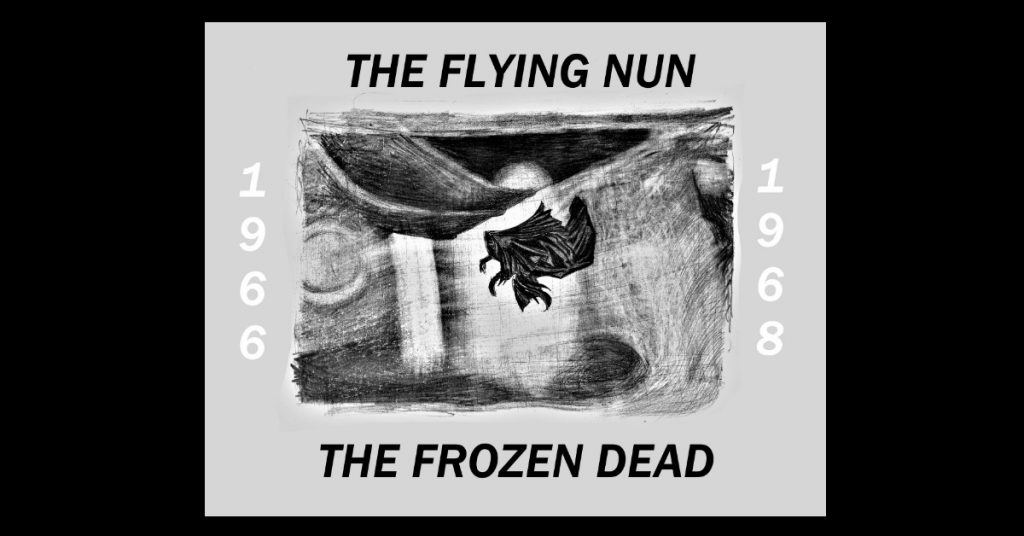Recently deceased science fiction writer Harlan Ellison wrote a 1968 episode of the TV series, “The Flying Nun” in order, he said, “to fuck Sally Fields.” If he just had a chance to get close to her, he believed, he could persuade her to have sex with him. The episode was titled, “You Can’t Get There from Here.” Sister Bertrille (Field) crashes on a remote island after the wind dies down. Her glider-like head piece, or cornette, falls in the water and is torn, leaving her stranded. She discovers other castaways, a pair of feuding lovers, who eventually reunite and repair Sister Bertrille’s cornette with coconut milk. She flies to safety, and rescues the others. Sally Field despised the show. Many despised Harlan Ellison, notorious for his bullying, rage, misogyny and physical violence, though his many science fiction stories and screenplays, and boundless capacity for generosity and warmth, were equally loved.
The Frozen Dead (1966) was a British horror-science fiction film directed by Herbert Leder, who also wrote the screenplay for Fiend Without a Face (1958) (one of his best) about flying brain-sucking brains, and directed It (1967), a modern retelling of the Golem legend with Roddy McDowell (one of his worst). Leder was also a professor of film theory at Jersey City State College. One would have loved to have attended his classes. He was an ok teacher according to some of his students. The critics hated most of his movies, but loved certain moments in them: the stop-motion animated flying brain finale of Fiend Without a Face, (which, as they say, must be seen to be believed), and the living head on a table pleading to be buried at the finale of The Frozen Dead.
The Frozen Dead starred Dana Andrews as a former Nazi scientist working to revive frozen Nazi soldiers and generals for world conquest. He is successful bringing them back to life, but their brains are in a zombie state. To advance his research he keeps a murdered girl’s head in his lab. Her face is bathed in blue light (I didn’t know it was blue until years later, since the American release used black and white prints to save money), and her exposed brain is under a clear plastic dome. The head kept alive was played by a beautiful and talented English actor named Kathleen Breck, also known for her appearance in an episode of the British TV series “The Prisoner” with Patrick McGoohan. (One of the legions of critics panning The Frozen Dead singled out “Breck’s soulful head” for praise). In the film she exerts telepathic control over a row of arms sticking out of the lab wall, and commands them to strangle Dana Andrews. Andrews was a serious and very successful film actor through the 1940’s, and a long-time alcoholic. The standard narrative tells of a trajectory of decline through the ‘50’s and ‘60’s as his drinking took its toll, perhaps more in terms of his career choices than performances, though aging and a changing industry may have been more to blame, (if blame is the correct understanding). He achieved a hard-won sobriety by 1969, but his sober film work seemed no different, and even of less interest, than while he drank. Indeed, near the end of his drinking career (at its height, or its diminution?) his roles and films became ever stranger, and more compelling. The Frozen Dead is part of that pantheon. His “masculine mask” with a suggestion of inner torment won him awards and accolades in earlier films like Best Years of Our Lives (1946), Laura (1944) and A Walk in the Sun (1945). He was loved for his kindness and professionalism, but his self-hate made it more and more difficult to go on without a drink. His transition to Strange Andrews, (his masculine mask frozen into lurid rictus) was inaugurated with Night of the Demon (1957) and reached its strident apex, along with The Frozen Dead, in Hot Rods to Hell (1967). From one point of view (a precipice of feverish cinephilia well into the amour-fou) Hot Rods to Hell is his greatest film. It must be seen to be believed.
ARTWORK BY GREGG WILLIARD

